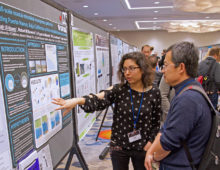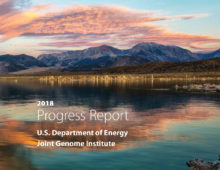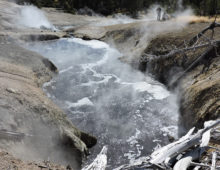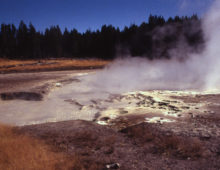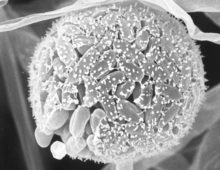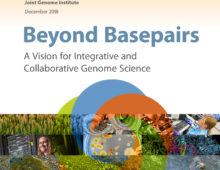Twice a year, the DOE Office of Science Graduate Student Research (SCGSR) program awards graduate students the opportunity to pursue part of their thesis research at one of the DOE national laboratories or national user facilities. As a result of the latest call, a total of 70 graduate students from 52 universities were selected to…
Notes on the Microbial Diversity of Puerto Nuevo’s Coastline
Puerto Nuevo is a small town along the Baja California coastline in Mexico. While conducting early field studies related to her thesis on cone snails, UC Merced graduate student Sabah Ul-Hasan and alumnus of the JGI-UC Merced Genomics Internship Program, first sampled the area in summer 2016. She described the microbial diversity patterns of Puerto…
Year in Review: JGI’s 2018 Progress Report Available Now
The latest edition of the JGI Progress Report highlights notable research and scientific collaborations in 2018. The cover is an image of Mono Lake, a saline soda lake east of California’s Yosemite National Park, taken by JGI’s own Jon Bertsch. Microbes isolated from Mono Lake were sequenced by the JGI (isolates here, here and here),…
The Expanding Universe of Methane Metabolisms in Archaea
Metagenome-assembled archaeal genomes provide new insights into an ancient metabolism. Methane is a greenhouse gas 20 times more potent than carbon dioxide. Billions of years ago, methane-producing archaea likely played a key role in determining the composition of the Earth’s atmosphere and regulating the global climate for life to flourish. For Guillaume Borrel and Simonetta…
Soil Aggregate as a Biogeofunctional Island
Soils are one of the most valuable resources for our nation, sustaining fiber, food and energy sectors. Soils harbor a diverse set of microbial communities that is three times higher than all other environments combined, but we have yet to develop a framework for microbial community assembly in terrestrial systems at spatial scales that are ecologically-relevant for microbes. Aggregates constitute the physical microstructure of the soil, influencing drainage, nutrient levels, and biogeochemical cycling. We propose to study this system using the soil aggregate as an unit for microbial community processes and functions.
Tracking the Origins of Methane-Producing Microbes
Mini-Metagenomics Approach Helps Identify Novel Archaeal Methane Metabolism. Methane-producing archaea are estimated to produce 500 million tons of methane a year, which is over half the total global methane production. They are thought to use billions of tons of the carbon dioxide trapped in biomass each year to do so. As such, they are considered…
Evolution of a Fungal Gene Expression Regulator
5mC is an important piece of how many organisms regulate their genomes, but it is not well understood in fungi. Researchers reported on the largest analysis of 5mC distribution across the fungal tree of life to date, involving more than 500 species of fungi.
JGI Hosts GPU Hackathon in May
Submit proposals focused on the bioinformatics community by March 1st. WHEN: May 6-10, 2019 WHERE: JGI With DOE investments in graphical processing unit (GPU)-based high-performance computing resources, an upcoming hackathon led by the Oak Ridge Leadership Computing Facility (OLCF), NVIDIA, and the Department of Energy (DOE) Joint Genome Institute (JGI), a DOE Office of Science…
JGI Launches Latest Strategic Plan
For the Joint Genome Institute, the end of 2018 was marked by a celebration of contributing over one “petabase” – a quadrillion nucleotide bases of DNA sequence to the public data repositories over its now 20-plus-year history. In 2019, the countdown has begun to the June dedication event of the Integrative Genomics Building—the new home of…
Waiting to Respire
Genomes from uncultivated bacteria offers clues to ancestral bacteria’s energy sources. More than two billion years ago, cyanobacteria acquired the ability to produce their own food and generate oxygen as a byproduct. The abundance of oxygen shaped the evolution of life on Earth, and led to the development of multicellular organisms. Not all bacterial lineages…

